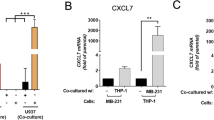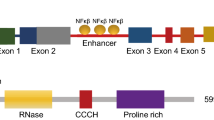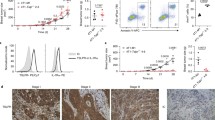Abstract
The C–C chemokines, macrophage inflammatory protein (MIP)1α and MIP1β are potent chemoattractants for the monocytes, which form an important component of the stroma of tumor tissue and may regulate tumor growth and associated inflammation. We examined the role of MIP1α and MIP1β in inducing the release of inflammatory cytokines and the generation of tumoricidal monocytes from the peripheral blood monocytes (PBM) of healthy women and patients with carcinoma of breast (CaBr). Interleukin-1 (IL-1) and tumor necrosis factor (TNF) α release by the PBM was markedly stimulated by MIP1α in CaBr patients, but only marginally so in healthy women. In contrast, MIP1β stimulated the release of these cytokines by the PBM of healthy women, but failed to do so in CaBr patients. MIP1α, but not MIP1β, synergized with LPS in inducing the release of IL-1 from the PBM of both healthy women and CaBr patients. Both MIP1α and MIP1β augmented respiratory bursts in PBM and generated tumoricidal PBM that killed T24 cells, MIP1α being more effective in CaBr patients and MIP1β in healthy women. IFN-γ co-stimulated and IL-4 suppressed MIP1α and β-induced cytotoxicity in PBM. The synergy of IFN-γ was more marked with MIP1α than with MIP1β. The differential effects of MIP1α and MIP1β on the PBM of healthy women and CaBr patients co-related with the levels of expression of CCR1 and CCR5 in these monocytes. The expression of CCR5 was higher than that of CCR1 in the PBM of healthy women and the PBM of the CaBr patients showed overexpression of CCR1 and downregulation of CCR5.






Similar content being viewed by others
References
Asano T, An T, Jia SF, Kleinerman ES (1996) Altered monocyte chemotactic and activating factor gene expression in human glioblastoma cell lines increased their susceptibility to cytotoxicity. J Leukoc Biol 59:916
Austrup F, Vestweber D, Borges E, Lohning M, Brauer R, Herz U, et al. (1997) P and E-selectin mediated recruitment of T helper 1 but not T helper 2 cells into inflamed tissues. Nature 385:81
Baggiolini M, Dewald B, Moser B (1994) Interleukin-8 and related chemo tactic cytokines-CXC and CC chemokines. Adv Immunol 55:97
Beckner SK (1997) G-protein activation by chemokines. Methods Enzymol 288:311
Bellone G, Turletti A, Artusio E, Mareschi K, Carbone A, Tibandi D, et al. (1999) Tumor associated transforming growth factor beta and interleukin –10 contribute to a systemic TH-2 immune phenotype in pancreatic carcinoma patients. Am J Pathol 155:537
Chakraborty A, Chakrabarty NG, Chattopadhyay U (1996) Prolactin responses of NK cells but not of LAK cells is deficient in oral cancer patients. Int J Cancer 66:65
Chattopadhyay U, Biswas R (2002) Prolactin regulates macrophage and NK cell mediated inflammation and cytotoxic response against tumor. In: Rapaport R, Matera L (eds) Growth and lactogenic hormone, vol 2. Neuroimmune biology Elsevier science. Amsterdam, p 227
Chensue SW, Ruth JH, Warmington K, Lincoln P, Kunkel SL (1995) In vivo regulation of macrophage IL-12 production during type 1 and type 2 cytokine mediated granuloma formation. J Immunol 155:3546
Cianciolo GJ, Hunter J, Silva J, Haskill JS, Snyderman R (1981) Inhibitors of monocyte responses to chemotaxins are present in human cancerous effusions and react with monoclonal antibodies to P15 (E) structural protein of retroviruses. J Clin Invest 68:831
Cohn ZA (1978) The activation of mononuclear phagocytes: fact, fancy and future. J Immunol 121:813
Conlon K, Llyod AR, Chattopadhyay U, Lucas N, Kunkel S, Schall T, et al. (1995) CD8+ and CD45RA+ human peripheral blood lymphocytes are potent source of macrophage inflammatory protein 1 alpha, IL-8 and RANTES. Eur J Immunol 25:751
Cox GW, Chattopadhyay U, Oppenheim JJ, Varesio L (1991) IL-4 inhibits the co-stimulatory activity of IL-2 or picolinic acid but not of lypopolysaccharide on IFN-γ treated macrophages. J Immunol 147:3809
Decker T, Lohmann-Matthes MJ (1988) A quick and simple method for quantification of lactate dehydrogenase release in measurements of cellular cytotoxicity and tumor necrosis factor (TNF) activity. J Immunol Methods 15:61
Della-Rocca GJ, WanBiesen T, Daaka Y, Luttrell DK, Luttrell LM, Lefkowitz RJ (1997) Ras-dependent mitogen activated protein kinase activation by G protein coupled receptors. Convergence of Gi and Gq-mediated pathways on calcium/calmodulin, Pyk2 and Src kinase. J Biol Chem 272:19125
Dias S, Thomas H, Blackwell F (1998) Multiple molecular and cellular changes associated with tumor stasis and repression during IL-12 therapy of a murine breast cancer model. Int J Cancer 75:151
Fahey TJ, Tracey KJ, Tekamp-Olson P, Cousens LS, Jones WG, Shires GT, et al. (1992) Macrophage inflammatory protein 1 modulates macrophage function. J Immunol 148:2764
Flick DA, Gifford GE (1984) Comparision of invitro cell cytotoxic assays for tumor necrosis factor. J Immunol Methods 68:167
Ganju RK, Dutt P, Wu L, Newman W, Avraham H, Avraham S, et al. (1998) Beta chemokine receptor CCR5 signals via the novel tyrosine kinase RAFTK. Blood 91:791
Han J, Lee JD, Bibbs L, Ulevitch RL (1994) A MAP kinase activation by endotoxin and hyperosmomolarity in mammalian cells. Science 265:808–811
Huang S, Singh RK, Xie K, Gutman M, Berry KK, Bucana CD, et al. (1994) Expression of JE/MCP-1 gene suppresses metastatic potential in murine colon carcinoma cells. Cancer Immunol Immunother 39:231
Jablonska E, Kiluk M, Piotrowski L, Grabowska Z, Markiewicz W, Jablonski J (1998) Tumor necrosis factor-alpha and soluble tumor necrosis factor receptors in the culture supernatants of polymorphonuclear cells and peripheral blood mononuclear cells from cancer patients. Eur Cytokine Netw 2:155
Jiang Y, Beller DI, Frendl G, Graves DT (1992) Monocyte chemoattractant protein-1 regulates adhesion molecule expression and cytokine production in human monocytes. J Immunol 148:2423
Lee JC, Laydon JT, McDonnell PC, Gallagher TF, Kumar S, Green D, et al. (1994) A protein kinase involved in the regulation of inflammatory cytokine biosynthesis. Nature 372:739
Loeffler CM, Smyth MJ, Longo DL, Kopp WC, Harvey LK, Tribble HR, et al. (1992) Immunoregulation in Cancer bearing hosts. Down-regulation of gene expression and cytotoxic function in CD8+ T cells. J Immunol 149:949
Mantovani A, Bottazzi B, Collotta F, Sozzani S, Ruco L (1992) The origin and function of tumor associated macrophages. Immunol Today 13:265
Mantovani A, Vecchi A, Sozzani S, Sica A, Allavena P (1999) Tumors as a paradigm for the invivo role of chemokines in leukocytes recruitment. In: Rollins BJ (eds) Chemokines and cancer. Humana press, Totowa, NJ, p 35
Miller MD, Krangel MS (1992) Biology and biochemistry of the chemokines: a family of chemotactic and inflammatory cytokines. Crit Rev Immunol 12:17
Mizel SB, Oppemheim JJ, Rosenstreich DL (1978) Characterization of lymphocyte activating factor (LAF) produced by macrophage cell line P388D1. I. Enhancement of LAF production by activated T lymphocytes. J Immunol 120:1497
Mossman T (1983) Rapid colorimetric assay for cellular growth and survival: application to proliferation and cytotoxicity assay. J Immunol Methods 65:55
Nishioka Y, Sone S, Orino Nii A, Ogura T (1991) Down regulation by interleukin-4 of activation of human alveolar macrophages to the tumoricidal state. Cancer Res 51:5526
Opdenakker G, Van Damme J (1992) Cytokines and proteases in invasive process: molecular similarities between inflammation and cancer. Cytokine 4:251
Oppenheim JJ, Zachariae OC, Mukaida N, Matsushima K (1991) Properties of the novel proinflammatory supergene “Intercrine” cytokine family. Annu Rev Immunol 9:617
Pike E, Mizel D (1981) Rapid microassay for the measurement of superoxide and hydrogen peroxide production by macrophages in culture using an automatic immunoassay reader. J Immunol Methods 46:211
Pohlman TH, Stanness KA, Beatty PG, Ochs HD, Harlan JM (1986) An endothelial cell surface factor(s) induced in vitro by LPS, IL-1 and TNF-alpha increases neutrophil adherence by a CDW18-dependent mechanism. J Immunol 136:4548
Sallusto F, Lanzavecchia A, Mackay CR (1998) Chemokines and chemokine receptors in T-cell priming and Th-1/Th-2 mediated responses. Immunol Today 19:568–574
Schrum S, Probst P, Fleischer B, Zipfel PF (1996) Synthesis of the C–C chemokines MIP1α, MIP1β and RANTES are associated with a type 1 immune response. J Immunol 157:3598
Selvan RS, Kapadia HB, Platt JL (1998) Complement induced expression of chemokine genes in endothelium: regulation by IL-1 dependent mechanisms. J Immunol 161:4388
Singh RK, Berry K, Matsushima K, Yasumoto K, Fidler IJ (1993) Synergism between human monocyte chemotactic and activating factor and bacterial products for activation of tumoricidal property of murine macrophages. J Immunol 151:2786
Siveke JT, Hamann A (1998) Cutting edge: T helper 1 and T helper 2 cells responds differentially to chemokines. J Immunol 160:550
Taub DD, Conlon K, Lloyd AR, Oppenheim JJ, Kelvin DJ (1993) Preferential migration of activated CD4+ and CD8+ T cells in response to MIP1α and MIP1β?. Science 260:355
Taub DD (1999) Natural killer-cell-chemokine interactions. In: Rollins BJ (eds) Chemokines and Cancer. Humana press, Totowa, NJ, p 35
Wang JM, Chertov O, Proost P, Li JJ, Menten P, Xu L, et al. (1998) Purification and identification of chemokines potentially involved in kidney-specific metastasis by a murine lymphoma variant: induction of migration and NF kβ activation. Int J Cancer 75:900
Wang JM, Deng X, Gong W, Su S (1998) Chemokines and their role in tumor growth and metastasis. J Immunol Methods 220:1
Wang JM, Shen W, Chertov O, Van Damme J, Oppenheim J (1999) Chemokine modulation of tumor cell physiology. In: Rollins BJ (eds) Chemokines and Cancer, Humana Press, Totowa, NJ, p 129
Wiltrout RH, Varesio L (1990) Activation of macrophage for cytotoxic and suppressor effector functions. In: Oppenhein JJ, Shevarch EM (eds) Immunophysiology. The role of cells and cytokines in immunity and inflammation. Oxford University press, NY, pp365
Zachariae CO, Anderson AO, Thompson HL, Apella E, Mantovani A, Oppenheim JJ, et al. (1990) Properties of monocyte chemotactic and activating factor (MCAF) purified from a human fibrosarcoma cell line. J Exp Med 171:2177
Zella D, Barabitskaja O, Burns JM, Romerio F, Dunn DE, Revello MG, et al. (1998) Interferon γ increases expression of chemokine receptors CCR1, CCR3 and CCR5, but not CXCR4 in monocytoid U937 cells. Blood 91:4444
Acknowledgements
The authors wish to thank Dr. Ji Ming Wang for reviewing the work, Dr. Ratna Biswas for editorial assistance, and Mr. Sumit Kr. Majumder for secretarial help.
Author information
Authors and Affiliations
Corresponding author
Rights and permissions
About this article
Cite this article
Nath, A., Chattopadhya, S., Chattopadhyay, U. et al. Macrophage inflammatory protein (MIP)1α and MIP1β differentially regulate release of inflammatory cytokines and generation of tumoricidal monocytes in malignancy. Cancer Immunol Immunother 55, 1534–1541 (2006). https://doi.org/10.1007/s00262-006-0149-3
Received:
Accepted:
Published:
Issue Date:
DOI: https://doi.org/10.1007/s00262-006-0149-3




